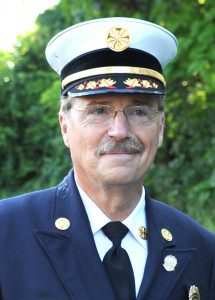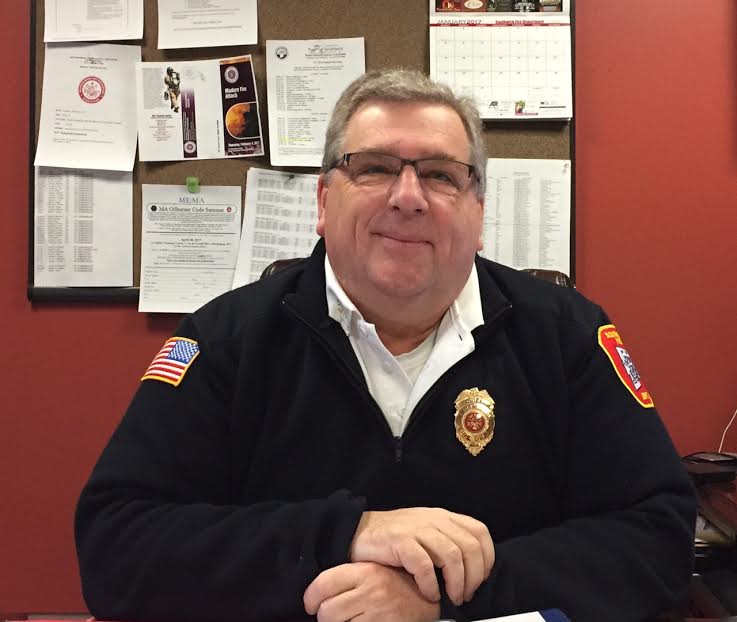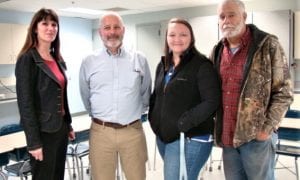SOUTHWICK – The Southwick Fire Department is a solid service provider, said Fire Chief Richard Anderson.
Since taking over as full-time chief last year, Anderson has concentrated on staffing and increased the volunteer firefighter/EMT staff to 52, which is up 25 members since 2010. He also worked to increase the number of full-time staff so that there is full-time coverage every day from 6 a.m. – 6 p.m.
“We will have four full-time employees on the day shift, which is our busiest time,” said Anderson.
Before Anderson became chief, he served as a volunteer deputy since 1991, then became interim chief in 2010 and was appointed the full-time chief last year. In 2010, there was only one full-time employee besides he chief. Since increasing staff, the department is providing better, more consistent service.
“We’re getting a great response time,” said Anderson, adding that the need for EMS is expanding everywhere.
“EMS across the country is growing,” he said. “People used to call doctors to their home, but they don’t make house calls anymore and people are calling ambulances.”
Anderson said most calls for ambulances come from senior citizens and there are five elderly complexes in town.
“We often have multiple calls at once,” said Anderson.
In that case, the two full-time EMTs respond to one call, while volunteers respond to the second.
“Our volunteers are great – they sometimes leave their jobs to respond,” said Anderson. “I don’t even know where they come from. They just show up.”
Anderson said, as far as apparatus is concerned, the SFD is in good shape.
“We have good apparatus and we just acquired a boat,” he said.
The boat, which was given to the department for free from the Coast Guard, saved the department a lot of money.
“It is being lettered by Southwoods, was painted by Southwick Collision and Saunders Boat is helping us find a secure dock,” said Anderson. “We want it to be docked securely at the lake.”
The boat is another way for the SFD to deliver services in town.
“We’re a recreational town. It’s not just streets, but it’s woods and lakes,” said Anderson. “We deal with jet skis, boats, snowmobiles and more.”
The SFD recently switched its dispatch services to emergency medical dispatch, a mandated move that was implemented July 1.
Under the new policy, dispatchers begin EMS as soon as a 911 called is answered.
“This extends the EMS service,” said Anderson. “Instead of starting when responders arrive, the service begins at that phone call.”
Dispatchers now stay on the phone with medical emergency callers and can offer instructions for others in the residence to begin CPR.
“We had to buy new software, which we got through a grant,” Anderson said.
For a town the size of Southwick, the fire department is on par with larger communities in its capabilities and response. However, Anderson hopes to offer even more in the near future.
“What I’d like to do is move into the advanced life support realm,” said Anderson.
In order to do that, the SFD has to employ paramedics.
“We’re trying to go in that direction, slowly,” he said. “We have one paramedic on staff now and two entering paramedic school.”
Anderson said he hopes the increase in ambulance receipts will cover the costs associated with switching to advanced life support. Right now, the town generally uses Westfield and Agawam for such services and pays a flat rate for the service. The ambulance receipts currently cover EMS costs. Anderson said tax dollars pay the firefighter side of the department, which has a $300,000 budget. Anderson added that he is looking into grants to pay for items needed to become a paramedic department, such as a heart monitor and medications.
“We think we can do this reasonably over time,” he said, adding that he is not looking into becoming a complete full-time department.
“That would be way into the future,” he said. “As long as we have the proper coverage in the daytime, we’re okay.”
Anderson said the department’s number one concern is taking care of Southwick residents.
“We know in the next year 1,500 people will call 911 for our services,” he said. “We don’t know when they’re going to call and we don’t know what they’re going to call for, but we know they’re going to call, so we have to be trained, equipped and ready to go.”





